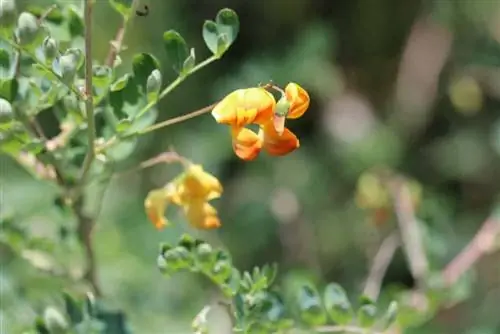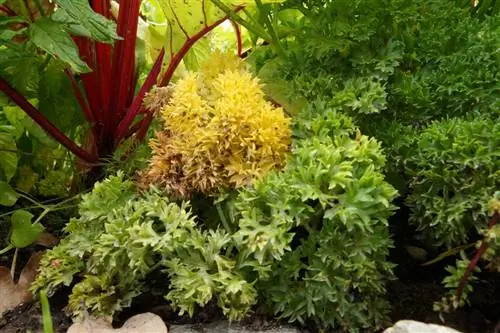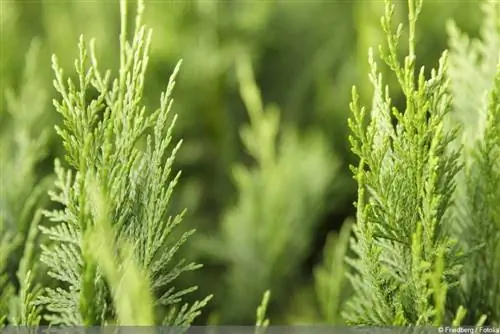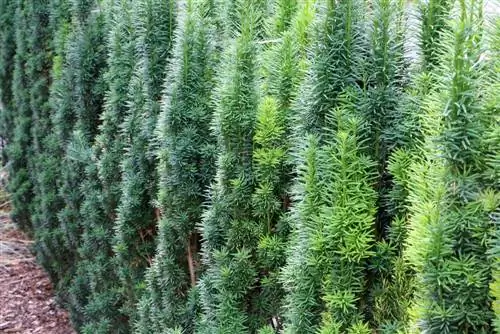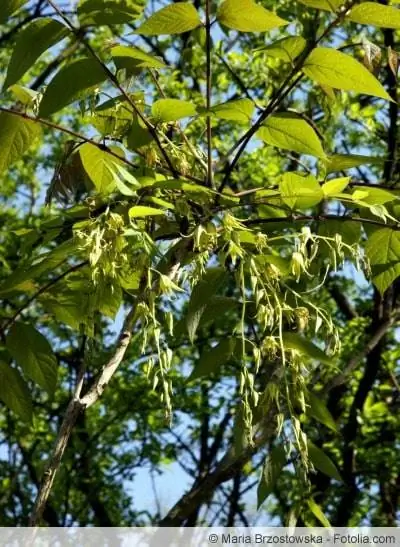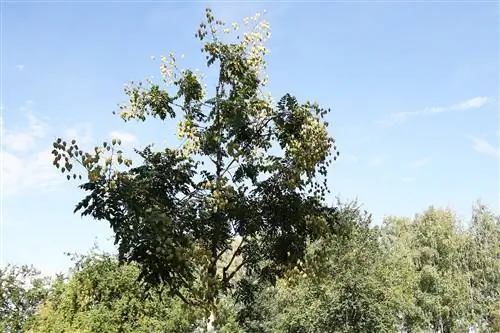- Author admin [email protected].
- Public 2023-12-17 03:39.
- Last modified 2025-01-24 12:45.
In the natural garden, the yellow bladder bush impressively demonstrates how ecology and aesthetics go hand in hand. With a lavish bloom of bright yellow, followed by decorative legumes in autumn, the ornamental tree delights insects, birds and gardeners alike. The Colutea arborescens is so frugal that it thrives as a pioneer tree even under barren conditions. The only downside is the toxic content of its leaves and seeds. The following lines explain how to properly care for the yellow bladder bush.
Location
In creative garden design, a yellow bladder bush takes on a variety of tasks. It fits harmoniously into a mixed hedge thanks to its sociability. In addition, it is available where a steep embankment needs to be fortified. Because of its deep taproots, nothing will slip here easily. Its graceful silhouette also qualifies the Colutea arborescens as a magnificent solitaire that attracts everyone's attention. If the site conditions meet its low demands, the ornamental shrub meets all expectations placed on it.
- Sunny location up to light partial shade
- Congested summer heat is tolerated
- Light wind exposure is acceptable
Native to southern Europe, the bladder bush also prefers warm garden spots without cold drafts in the local regions. This preference does not detract from its winter hardiness, as it has shed its leaves at this time of year.
Soil texture
If you assign the ornamental tree a spot in full sun, it will feel extremely at home there if the soil is as follows:
- Sandy, dry and with some clay
- Low in nutrients and humic
- High permeability
- A pH value greater than 7 is ideal
The yellow bladder bush will not develop its beauty in permanently moist or even acidic soil. Especially in compacted soil, its taproots do not penetrate and the tree collapses.
Watering and fertilizing
In order to properly care for a yellow bladder bush, extreme restraint is required when it comes to water and nutrient balance. A well-established tree makes do with the natural rainfall. Watering should still be carried out during summer drought periods so that the plant does not come under drought stress. A fixed fertilization schedule is not necessary. If you are already out in the garden with a wheelbarrow of compost, the Colutea arborescens will be happy to receive a portion. The administration of nutrients ends in August so that the shrub can mature before winter. If there is an oversupply of nutrients in late summer, additional branches will sprout, the soft tissue of which will freeze back with the first frost. This process weakens the shrub as a whole and makes it susceptible to diseases and pests.
Tip:
Starting fertilization in March/April in the form of compost, cattle manure and horn shavings promotes the vitality of a yellow bladder bush.
Cutting
Thanks to its uncomplicated care, the bladder bush is often found in public parks and facilities. Here, its visual appearance suffers significantly within a few years because a central aspect is not taken into account. The ornamental tree only develops an attractive stature if it is pruned once a year. Otherwise it will spread in all directions, become increasingly woody and become bald from the inside out. As a result, the beautiful labial flowers only thrive lonely and isolated at the tips of the branches. The Colutea arborescens will not suffer such a fate in a well-kept hobby garden, because here it is cut in early spring. Pruning the summer flowering plant immediately after flowering is a significant disadvantage for two reasons: Late pruning causes autumnal shoots that will freeze in winter. The magnificent legumes should not be removed because they adorn the shrub even during the cold season. How to cut a yellow bladder bush professionally:
- The weather is frost-free, dry and overcast
- The cutting tool is freshly ground and disinfected
- Gloves protect against contact with the toxic content
- Cut old, dried branches at the base
- Cut off branches that are directed towards the interior of the bush and that cross each other
- Lighten out so that light and air reach all areas
- Short shoots that are too long by a maximum of a third
The rule of thumb for spring pruning is that heavy pruning causes intense growth and vice versa. When making a proper cut, the only thing that needs to be taken into account is that the scissors are always placed 2-3 mm above a bud. A slight tilt ensures that plant sap and rainwater can drain away better. This caution prevents a fungal infection.
Tip:
Yellow bladderwort clippings are toxic to horses and should never be disposed of in a pasture.
Propagate
If successful care has awakened your desire for more Colutea arborescens specimens, you have the choice between two methods of propagation:
Sowing
If the toxic content of the seeds doesn't scare you, collect them from the legumes in autumn or buy the seeds from specialist retailers. The best time for sowing is early spring. Here's how to do it:
- Fill small pots with seed soil, perlite or peat sand
- Insert 1-2 seeds in each about 1 cm deep
- Moisten with water from the spray bottle without wetting the substrate
- Expect germination in a partially shaded window seat at 20-25 degrees Celsius
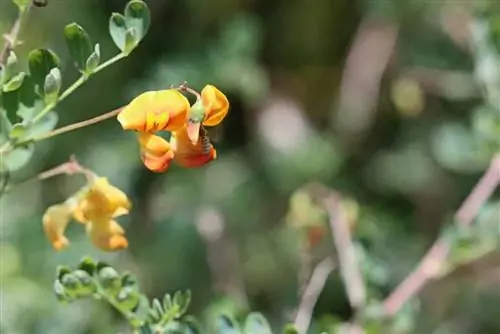
The first leaves develop within 1-3 weeks, which are quickly followed by more. Continue to keep the substrate slightly moist. If several plants grow in the seed container, the weaker seedlings should be sorted out when they reach a height of 5 cm. Once the young plants have rooted completely through the pot, they are planted out into the bed.
Cuttings
A good time for propagating cuttings is early summer. Semi-lignified shoots with a length of 10-15 cm are ideal. This is how the offshoots transform into young bubble bushes:
- Defoliate the lower half of each cutting
- Fill small pots with lean potting soil or standard soil (TKS1)
- Insert a cutting with the defoliated part in it
- Moisten the substrate and put a plastic bag over it
Placed in a partially shaded, warm place, each cutting develops its own root system. During this phase the soil must not dry out. A fresh shoot signals the successful course of propagation. The plastic bag is no longer necessary. The young plant now welcomes a few hours of sunshine a day. Once the cultivation container is completely rooted, the bladder bush is repotted in a mixture of one third each of standard soil, perlite and sand. Throughout the winter, care for it properly in a light or dark place at temperatures of 0-5 degrees Celsius. A sip of water every now and then prevents the soil from drying out. Next spring plant a vital, robust Colutea arborescens in the bed.
Origin and description
The bladder bush has its home in the Mediterranean and North Africa, but can also be found in the wild here. It grows up to five meters high and blooms with golden yellow flowers from May to the end of summer. After pollination, the flowers develop into legumes with seeds that can be up to eight centimeters long. They are initially green, later turn slightly reddish and then become parchment-like.
These pods contain carbon dioxide and therefore look inflated, which is how this plant got its name. They often remain on the bush throughout the winter, making for a beautiful decoration in the garden during this time too. During strong winds, the pods are torn from the bush and carried to other locations, causing this plant to spread further. Otherwise, the pods will dry out over time and then release their seeds. Because the bubble bush has a long flowering period, flowers and fruits can often be seen on the bush at the same time.
Poisonousness of the plant
The bladderwort is a poisonous plant and can cause problems for humans and animals. Its leaves and seeds contain mild toxins that cause nausea, vomiting and diarrhea when consumed. The bladder bush is therefore only partially suitable as an ornamental plant for the garden for households with small children or pets. However, due to the unpleasant smell and bitter taste of the seeds, children are at little risk in this regard.
Leaves and seeds were once used in natural medicine to treat constipation because of their laxative properties, but these days they are no longer used.
Conclusion
The yellow bladder bush provides convincing evidence that a closeness to nature and a sense of horticultural beauty do not have to be mutually exclusive. As early as spring, the tree unfolds its bright yellow flowers, over which bumblebees, bees and butterflies cheer until well into August. This is followed by the eye-catching legumes, which provide food for birds during the cold season. All of these ecological advantages go hand in hand with a magnificent appearance both as a solitary plant and in the hedge. In return, a Colutea arborescens only expects a sunny, sandy, dry location and a little water in dry conditions. In order to care for it properly, the focus is on annual pruning. This measure keeps the ornamental tree in shape and always attracts the enchanting flowers.

